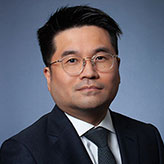June 27, 2025
The Next Wave in Emerging Markets

This month, we interviewed Matthew Strauss, the portfolio manager of our emerging markets mandate. Mr. Strauss has over 25 years of investment experience and is an expert in global and emerging markets equities.
Alfred Lam: U.S. market performance has been exceptional while emerging markets have lagged in the last decade. Can you explain what drove this result?
Matthew Strauss: There’s no arguing that the last decade was a decade of U.S. exceptionalism and outperformance. During the first few years after the Great Financial Crisis of 2008, emerging market equities continued their outperformance. However, since 2013, U.S. internet and technology stocks have kicked off a decade of U.S. equity outperformance, pulling in capital from all corners of the world. Outside the U.S., emerging markets outperformed the rest of the world for almost 7 years between 2016 and 2022 before receiving a one-two punch. Firstly, the biggest market in EM, China, started underperforming due to economic and regulatory challenges, and secondly, we saw the rise of the three “macro killers” of EM performance: higher U.S. rates, higher U.S. inflation and an appreciating dollar. In the past it had been almost impossible for EM to outperform when all three of these macro factors were present. All three factors are now in the process of either dissipating or turning into tailwinds for EM.
Alfred Lam: Do emerging countries such as China have bargaining power with the U.S. on the “tariff war”? Is there a winner?
Matthew Strauss: In a global tariff war there are only relative winners, not absolute winners. Economic theory and history suggest that increased tariffs will have a net-net negative impact on both economies. Who would lose the most depends on the details of the final agreement and how “tight” those rules are. Remember, back in 2018/2019, Chinese manufacturers simply re-arranged the supply chains to include production hubs in third-party countries to largely bypass tariffs.
As far as bargaining power is concerned, the fact that the Trump administration already had to walk back many of their tariff threats suggests that China and a number of U.S. trading partners might have more bargaining power than originally believed, especially as U.S. domestic resistance keeps building around the negative impact of tariffs on U.S. consumer and business sentiment and, critically, opinion polls.
Alfred Lam: Looking forward, why should one invest in emerging markets?
Matthew Strauss: Structural growth. Even after including a more challenging tariff regime, emerging market economies are still expected to grow over the longer term at more than twice the rate of their developed market peers and more than three times the rate of Europe and Japan. Strong growth leads to a growing middle class, which in turn leads to “up-trading” by consumers, a deepening of financial services, greater demand for health products and services and an increased desire for enhanced experiences. All this creates interesting and growing opportunities for the right companies.
Alfred Lam: Within the emerging markets universe, what countries do you favour and why?
Matthew Strauss: Countries with supportive demographics and economic reforms/policies are high on our favoured list, but today there are only few “clean” stories, as governments have to balance social demands with the need for growth in an overall lower-growth world. India and Argentina stand out in this regard. Indonesia, China and Mexico also show great potential, but come with more reservations, whether on the demographical or political front. Sector-wise, Taiwan and South Korea are also on our list, given their exceptional technology industries.
Alfred Lam: Can you also give us examples of sectors or companies that interest you?
Matthew Strauss: Technology, internet and software are high up on the list, given the developments and growth opportunities in these sectors. Taiwan Semiconductor Manufacturing (the dominant manufacturer of leading-edge chips) and SK Hynix (the leading memory manufacturer in the world) speak to the excellence of EM technology companies. Alibaba (China) and MercadoLibre (Latin America) have trumped Amazon in their home markets.
Elsewhere, consumer, healthcare and financial companies are key ways to invest in the income and wealth accumulation of EM households. Maruti Suzuki, the EV producer BYD and Banorte would be a few examples.
Alfred Lam: Lastly, what keeps you up at night?
Matthew Strauss: All these questions do. On a serious note, politics and changing policies have become such big drivers of returns – not only in emerging markets but also in developed markets – that it’s hard to imagine investing in any market without an informed macro view. Combining these macro uncertainties with great, high-quality companies and getting that mix right within a portfolio have become increasingly challenging as the one (politics) has become more volatile while the other (EM corporate governance and transparency) continues to improve.
Alfred Lam: Thank you so much for spending some time with us Matt!
Matthew Strauss: You are welcome.
About the Author
Alfred Lam, Senior Vice President, Co-Head of Multi-Asset, joined CI GAM in 2004. He brings over 23 years of industry experience to his portfolio design, asset allocation, portfolio construction, and risk management responsibilities, which include chairing the multi-asset investment management committee and sizing investment bets to drive added value and manage risk. Alfred holds the CFA designation and an MBA from York University Schulich School of Business. He is a recognized leader in multi-asset investing in Canada. During his tenure, his team has won multiple investment awards, including the Morningstar Best Fund of Funds, and saw assets growing four-fold.
IMPORTANT DISCLAIMERS
The opinions expressed in the communication are solely those of the author(s) and are not to be used or construed as investment advice or as an endorsement or recommendation of any entity or security discussed. This document is provided as a general source of information and should not be considered personal, legal, accounting, tax or investment advice, or construed as an endorsement or recommendation of any entity or security discussed. Every effort has been made to ensure that the material contained in this document is accurate at the time of publication. Market conditions may change which may impact the information contained in this document. All charts and illustrations in this document are for illustrative purposes only. They are not intended to predict or project investment results. Individuals should seek the advice of professionals, as appropriate, regarding any particular investment. Investors should consult their professional advisors prior to implementing any changes to their investment strategies.
Certain statements in this document are forward-looking. Forward-looking statements (“FLS”) are statements that are predictive in nature, depend upon or refer to future events or conditions, or that include words such as “may,” “will,” “should,” “could,” “expect,” “anticipate,” “intend,” “plan,” “believe,” or “estimate,” or other similar expressions. Statements that look forward in time or include anything other than historical information are subject to risks and uncertainties, and actual results, actions or events could differ materially from those set forth in the FLS. FLS are not guarantees of future performance and are by their nature based on numerous assumptions. Although the FLS contained herein are based upon what CI Global Asset Management and the portfolio manager believe to be reasonable assumptions, neither CI Global Asset Management nor the portfolio manager can assure that actual results will be consistent with these FLS. The reader is cautioned to consider the FLS carefully and not to place undue reliance on FLS. Unless required by applicable law, it is not undertaken, and specifically disclaimed that there is any intention or obligation to update or revise FLS, whether as a result of new information, future events or otherwise.
Certain names, words, titles, phrases, logos, icons, graphics, or designs in this document may constitute trade names, registered or unregistered trademarks or service marks of CI Investments Inc., its subsidiaries, or affiliates, used with permission. All other marks are the property of their respective owners and are used with permission.
Certain statements contained in this communication are based in whole or in part on information provided by third parties and CI Global Asset Management has taken reasonable steps to ensure their accuracy. Market conditions may change which may impact the information contained in this document.
